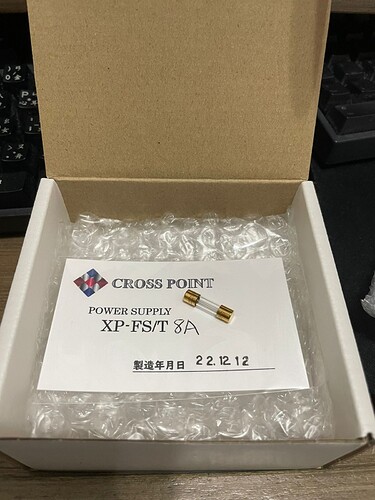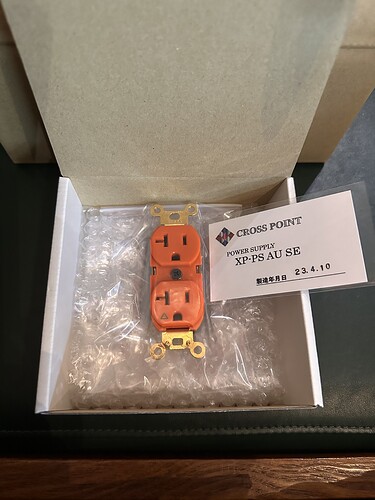so did a audiophile network switch for me.
But I think this is not generic, the effect more related the complete chain - therefore try, hear, keep or return.
And of course both DACs very identical, fed exact same signal, and output at exactly same volume level.
Wake me up when that “gentleman” (his name wasn’t P.T. Barnum by chance?) gets a Nobel prize for overturning the entire field of physics since at least Archimedes. Until such day he remain a common swindler, just like every other cable peddler.
Yes Huge difference for my previous R250! It is a must to extend the potential of the unit. Mine is using the SR purple but easily blown away by my another pc from Japan!
It looks normal but sound extraordinarily! !
I am using it now for my power amp.
Some audio manufacturers would even has choices for fuse upgrade. You won’t hardly believe the difference until you try it out by yourself and the receptacle also! Expensive but the best now so far from my hearing. It costs US$1,300 each
From Synergistic’s comedy gold website:
Yes, fuses are directional. Electricity should flow from the left to the right when you view the fuse.
Since most people, most likely, are plugging their devices into AC mains (AC, for the special children here, stands for alternating current), are we supposed to flip the fuse 60 times a second (for audiophiles in the North America), 50 times rest of the world to match the direction of flow?
And of course they have “burn-in” (LOL) period that, under most reasonable listening schedules conveniently exceeds the money-back guarantee period.
It takes some very special level of being intellectually challenged to actually give these people money…
Do you really think that changing a fuse will change the sound of the system?
If yes, why not try normal fuses from different brands first?
I use SR Orange Quantum fuses in PS Audio DAC, but it was included when I bought it. I have a spare in case needed. I did not measure the difference between LE vs HE fuses yet, so I cannot tell if there is any difference.
I did spend a significant amount in room acoustic treatment (about 12K over a period of about the last 4 years in order to be able to pay for ) in “art-novion” pannels, sub and bass traps.) (https://www.artnovion.com). Half of it is second hand or demo equipment that went obsolete for sale.
As I also keep measurements before and after each change in the system, I can advise you on the level of acoustics , this 12 K-EUR is the best money I ever spend, as the gains are enormous in audio quality, RT60, and musical clarity (C80) en definition (D50), blackness of ground noise, …
I also agree on the allusion that investing in acoustic treatment first is far better than investing in details such as fuses and expensive cables.
Saying Investing in better (and frequently more expensive) interlink cables would be complete “perlimpimpin” ??? ( I love it too  ) is one bridge too far as I have several proof on measurement level there is a difference.
) is one bridge too far as I have several proof on measurement level there is a difference.
Once acoustics are improved, nuances on details coming from other interlink or speaker cables, power sine regenerators such as PS audio P3, P5, … and other (minor) upgrades will start to be audible and even measurable in the audio system. So investing in better cables could be beneficial. (on fuses I don’t know yet as I did not test it yet, and not planning too in the near future)
One example Last February I changed my subwoofer XLR interlink cables for my 2 x SVS-SB16 subs from a regular XLR Neo-W XLR interlink to mid-end Viablue NF-S1 XLR (2ch x 5m from the preamp towards the Sub1 and daisy chaining with 2ch x 10 m to Sub2. )
In annex an average of several measurements before and after changing the cables. (exact same calibration settings and dbfs , no obstacles or changes in surroundings, same sub and bass trap settings.
Results, see for yourself between 1,5 to 2 db delta between before and after (Orange = Before change / Purple = After change). (As from about 1 db, human ear can notice the differences). As a conclusion I tuned my subs 1db down, to avoid clarity loss in higher harmonic frequencies. so no “perlimpimpin”, these are facts.
The proof is in the pudding  , so why not try it, …
, so why not try it, …
This is very interesting. Were both measurements taken at the same time with the exact same microphone location?
Not exact but before noon and noon during weekend (so more silent than weekdays). Mic on the exact same location and distance as always. 315 cm from main speakers middle point
Eventhough time for subs is less sensitive in my experience.
The high freqs are more sensitive to this, …
Interesting. Would be quite neat if it did make a different, but air temperature and humidity might have been different, too.
It’s interesting that they track pretty well up to 100Hz or so, difference possibly explainable by lower resistance of a fancier cable (you’d hope it is at least thicker) but start diverging quite a bit at higher frequencies/shorter wavelengths.
I’ll have to try that in one session, swapping MIT cables for some generic lamp cord and back…
My hypothesis is indeed the difference capacitance/m and as you say lower resistance.
My subs consume a bit less now to produce the same output. 

I encountered even bigger differences (measuring was not even needed) in phono interlink cables when I was still using the Project RPM5 with Moon LP310 Phono Preamp and Rose RS250 (ADC conversionfunction) half a year ago.
Waiting for another 2 weeks on a Project Xtension X10 with Cadenza Black cartridge, and optional Audioquest Angels PSS tonearm cable. I’m curious on the results.
That’s always good, might even pay for itself after a while 
By the way, how do you like SB16? I have SB-2000 Pro where the Rose 520 will go, when it finally gets here, but it might be slightly small for a Texas-sized room  and I think my wife will flip if I put two subs there (although that would be better), so I was looking at one… Either that, or pick up a pair of Triton References when I get the 520…
and I think my wife will flip if I put two subs there (although that would be better), so I was looking at one… Either that, or pick up a pair of Triton References when I get the 520…
Artnovion probably has the greatest impact though, I just don’t even want to think how much it would cost to treat every room where I listen to music in here… Convolution filters in Roon help too, though.
see pm  as we are going too much off topic here
as we are going too much off topic here
+1 on the fuse “snake oil”. As an EE and enjoying this hobby for over 30 years you realize that the most important factors are:
- Good conductors
- Good connectors or no connectors
- Secure connections (using a combination of soldering and mechanical crimping)
This means utilizing OCC pure copper (silver you want the best IACS conductivity) wherever you can.
Any type of mods I have done on the IEC inlet/power supply areas has never yielded “improved/better” sound. I do these mods to create a cleaner signal path, eliminating unnecessary switches, fuses, upgrading wiring. In most cases newer electronics have secondary fusing at the power supply board/circuitry, so eliminating the IEC inlet fuse is not a concern for me.
I’m a huge proponent to try it for yourself. If you think a tweak makes your listening experience better, then that’s a winning outcome…
Indeed.
Yup. It sometimes makes sense to get more expensive (analog) cables, if you don’t feel like soldering yourself, just to get higher quality connectors, but that’s about it.
Sorry - I was talking about people in general, not you specific.
I have spend around the same amount in acoustic treatment, some also of Artnovion.
in addition I went with active Bass Absorbers (PSI Audio AVAA C20) to get rid of any standing wave.
I’m not using any Sub as I live in a house with several neighbors, which do not like Subs - in the End, I would have to go with DSP (which I could, my processors run Dirac), but I did so far never see the advantage for me in my room.
Fuses are just a little thing - and little things do have their costs. Same goes for cables.
Currently I’m happy with mine - I will see over time.
I agree with all posts to enhance first the big things in audiophile chaine……and then perhaps you hear a difference by replacing a fuse.
Never forget that any electrons like to pass from IN to OUT without any obstacles.
Obstacles means any cristal inconveniences in the copper.
Since I changed all !!! My cables with any 5N, 6N …… silver coated copper ….and and and by cables produced with only !!! copper OCC (Ohno Casted Copper) the improvement was amazing. So I will change any fuses.
Try the Scottland manufacturer driven by only engineers to find the best way for electrons in 1 !!! Cristal OCC copper cables: I will never miss Atlas Cables, the simple way by copper cables.
So the fuse marketing is the best moneymaker ….for the production company.
The way for electrons in 15 mm metal compared with meters of other cables……big question mark.
The best way NO fuse…….
Excuse me but I prefer to write in french because my english is not very good.
Je vous propose la manip suivante : enlevez le fusible et remplacez le (momentanément bien sûr) par un bout de câble identique à celui qui arrive avant le fusible. Faites vos comparaisons, si un fusible fait une différence, jetez le !!



